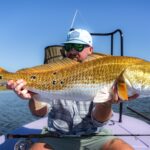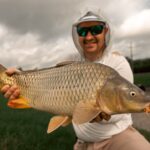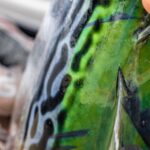
Louisiana Bull Reds Up for Harvest Again: H.B. 604 Must Not Pass
Photo Credit: Carter Abramson | Trevor Johnson Every now and then, we encounter something so
In our worlds of fisheries and conservation, victories almost never occur in a bubble—they are predominantly the culmination of years of work from passionate communities. Most of us are anglers that intimately understand and appreciate our respective fisheries. We also understand that what happens to fisheries in other parts of the country and world affects the broader community. So, it makes perfect sense that we’re increasingly seeing conservation victories all over the country that were—in part—achieved through grassroots, community-driven initiatives. Just this last week, we witnessed two conservation victories that have almost no relation—other than the fact that the voice of many passionate anglers CAN achieve remarkable influence for the betterment and protection of shared resources and sustainable fisheries.
On Tuesday, The Environmental Protection Agency announced the welcomed news that Pebble Mine is finally dead, and Alaska’s renowned Bristol Bay watershed is protected from harmful mining projects.
Also, this week, on the exact opposite corner of the United States, an informal coalition of passionate fishing guides, organizations, and other stakeholders rallied to protect the tarpon fisheries and delicate ecosystems of South Florida from a money and fame-driven, live-streamed fishing tournament.
Pebble Mine was a 13-year battle that saw the entire fishing and larger outdoor recreation communities unite to influence decision-makers with one simple message: No Pebble Mine. You’d be hard-pressed to find many conservation-minded anglers who hadn’t heard of Pebble, how the mine would impact some of the world’s most productive salmon runs, or even had never seen the infamous “No Pebble Mine” bumper stickers. That level of education and outreach was due to incredible efforts from organizations like Trout Unlimited and the Wild Salmon Center.

These organizations and many others knew defeating Pebble Mine and protecting the Bristol Bay watershed would be no small feat. They understood the power of a motivated, energized, and grassroots-driven angling community would be fundamental to achieving this victory—well, those groups effectively tapped and deployed these communities to send emails and make calls to Congress, sign petitions, you name it. Hundreds of thousands of stakeholders, brands, and organizations stood together in opposition to Pebble Mine. And guess what—it took years, but Pebble Mine is dead. Good riddance.
“Today, the people and businesses in Alaska and across the country who stood up for Bristol Bay should take a bow, because their efforts have protected the world’s most important wild salmon runs and the communities that depend on them,” said Chris Wood, president and CEO of Trout Unlimited. “It’s long past time for Pebble to recognize that it will never have community or legal standing to develop this mine. Now, it’s time for us to further strengthen protections for the entire Bristol Bay watershed that match the scope of the threat to this special place.”
What happened in Florida took a different form but tells a similar story. Much like the coalition to defeat Pebble Mine, South Florida’s fishing communities know how to stand together and fight for their fisheries. They have taken the lessons learned elsewhere and matured into a powerful community that demands action. Just look at what industry leaders like Captains for Clean Water have done. They have flexed their influence to change the status quo for water quality issues that are destroying their fisheries and ecosystems.
So, you might ask “what happened exactly in Florida?”, because it was far less publicized than the prolonged and nationwide Pebble Mine fight. With very little warning, an offshore tournament entity known as Sport Fishing Championship (“SFC”) announced a three-leg tarpon tournament in Islamorada, Punta Gorda, and Sarasota that would be live-streamed across media platforms.

It may be difficult to identify the risks of this event from a high level. The devil is in the details when it comes to nationally publicized tarpon tournaments – and they don’t have a good track record in Florida. When SFC developed this tournament series, they opted not to consult the local guide communities. In Florida, fishing guides have assumed an important role in standing guard as stewards of Florida’s coastal resources. They best understand how to responsibly and sustainably interact with the delicate and highly-pressured Florida tarpon fishery.
An invitational tournament roster of non-local guides recorded for a major network presents an entire list of nightmares. First and foremost: spot burn. The intricacies of properly fishing migratory tarpon along these coastal communities are closely guarded by those “in the know”. A tournament of this caliber would document and promote hundreds of prime locations and migration lanes. This flea-market sale of tarpon intel could generate newfound, detrimental angling pressure at critical mile markers along annual tarpon spawning migration routes.
Utilizing non-local competitors also raises questions about the field’s navigational acumen (or lack thereof) being a threat to fragile ecosystems. Many of these fishing locations are shallow, filled with meadows of seagrass and supported by vital mangrove shorelines. Introducing waves of foreign boats to these ecosystems increases the likelihood of damaged flats left tattered with prop scars and dead grass, if not solely from the viewers hoping to recreate these fishing experiences following the events.
Shark interactions are a hot-button topic for southeast anglers, especially in Florida. Many anglers feared a promotion of this style could utilize tarpon-shark interactions to boost sensationalism and gain inappropriate exposure. In turn, interactions between sharks and the tarpon community could be promoted in a compelling light that negatively influences uneducated anglers and their behavior in these situations.

Nearly all the well-respected flats guides of the Florida Keys and South Florida took to social media to raise awareness. They tapped their organization allies in Captains for Clean Water, The Lower Keys Guides Association, the Florida Keys Guides Association, and the Boca Grande Fishing Association, making their opposition clear and resolute.
“Our guiding communities down here are often compared to ‘the canaries in the coal mine’ for the flats fisheries and broader inshore ecosystems,” said Capt. Andrew Tipler, President of the Lower Keys Guides Association. “So, when the guiding community started to sound the alarm and express our adamant concerns and opposition to this misguided tournament, that carried a lot of weight. Thankfully, SFC made the right call […] saying they would not hold another event down here without the support of the guides associations. We all need to understand how delicate our fisheries are and do what we can to protect them for the long term.”
Last week, the SFC announced they would be postponing their tarpon fishing TV spectacle, assumedly due to the unwavering opposition from these influential parties.
Both of these announcements show that your voice matters and our efforts to protect and improve fisheries all throughout our coastlines are achievable. The ASGA family saw this first-hand with Amendment 7 for striped bass management—the public showed out, and the ASMFC Striped Bass Board listened, for the most part. We’ll need this community support to keep stripers on track to rebuild by 2029 and in other initiatives, as ASGA continues to grow and expand into new areas.
Keep up the fight and stay engaged—congrats to all who worked on these successful campaigns to protect their ecosystems. You have our respect and support.

Photo Credit: Carter Abramson | Trevor Johnson Every now and then, we encounter something so

This past weekend, ASGA proudly sponsored the Dirty Carp Tournament in Louisiana — and no, you didn’t misread that.

After years of data pouring in from The Albie Project, advocacy, persistence, and support from

This morning, the Connecticut Environment Committee held a hearing on House Bill 6248, a bill
We rely on our members and donations to keep fighting for a sustainable tomorrow in marine conservation.
GIVE THE GIFT OF FISHERIES CONSERVATION THIS HOLIDAY SEASON. SHOP ASGA GOODS THAT FUND FISHERIES RESEARCH & ADVOCACY CAMPAIGNS
JOIN ASGA IN CALLING FOR CRITICAL MANAGEMENT ACTION AFTER YEARS OF SPAWN FAILURES & POOR MANAGEMENT.
By using this website, you agree to our use of cookies. We use cookies to provide you with a great experience and to help our website run effectively. To learn more, please review our privacy policy.